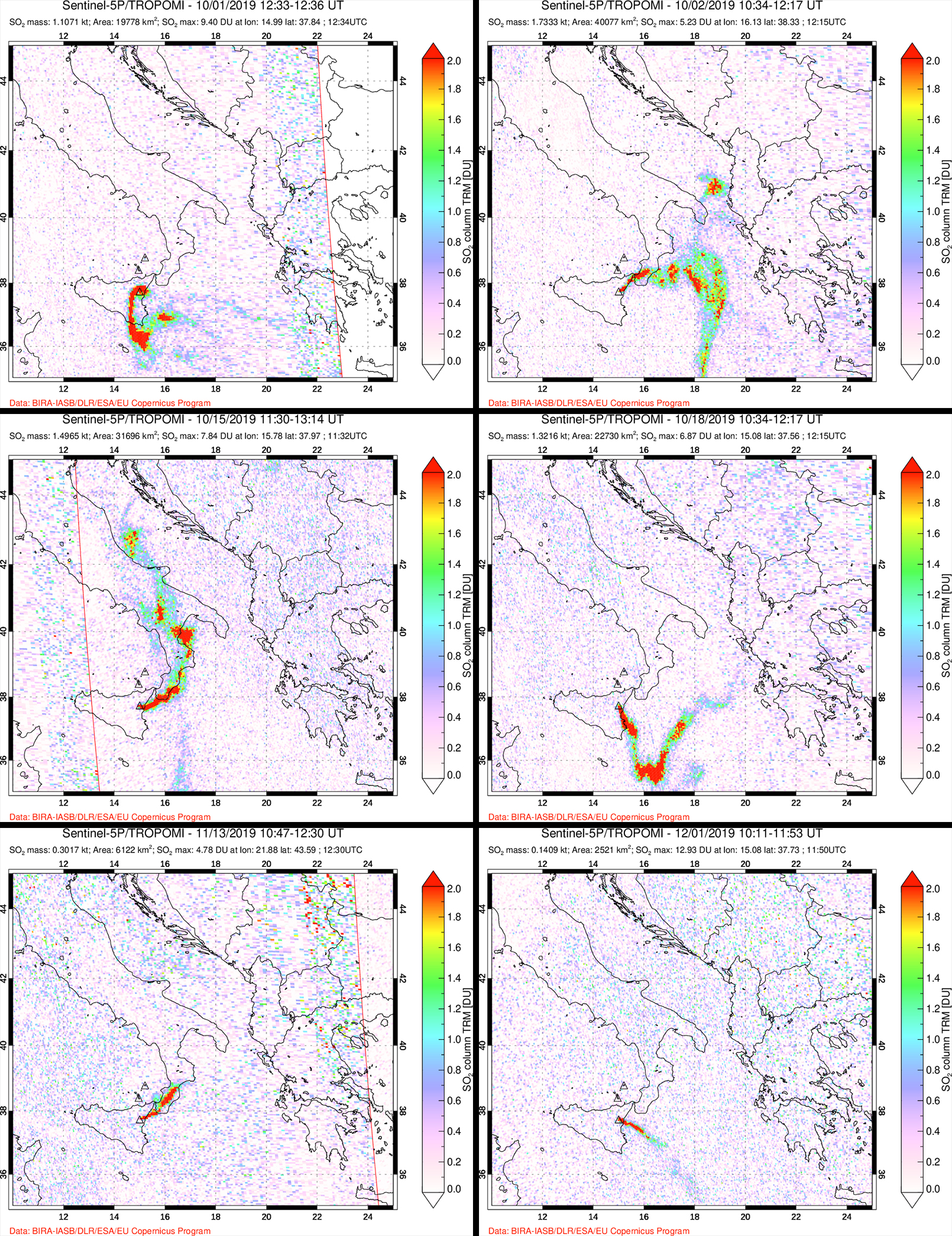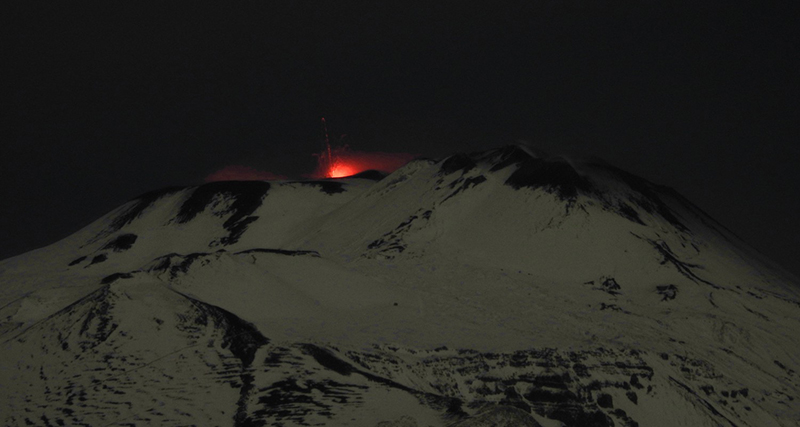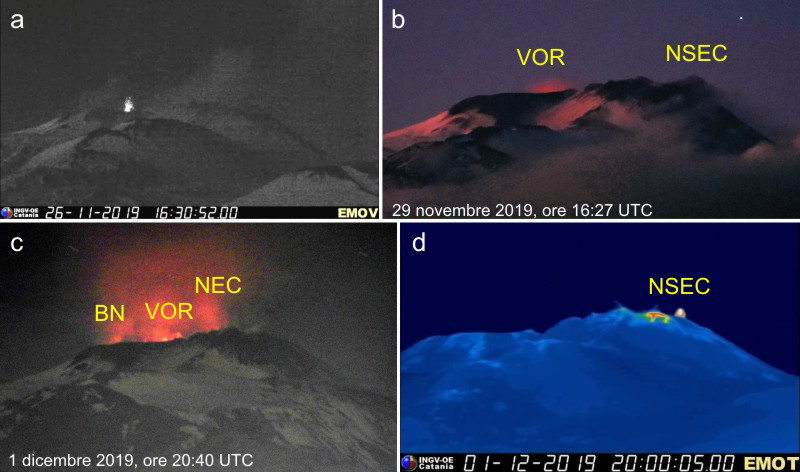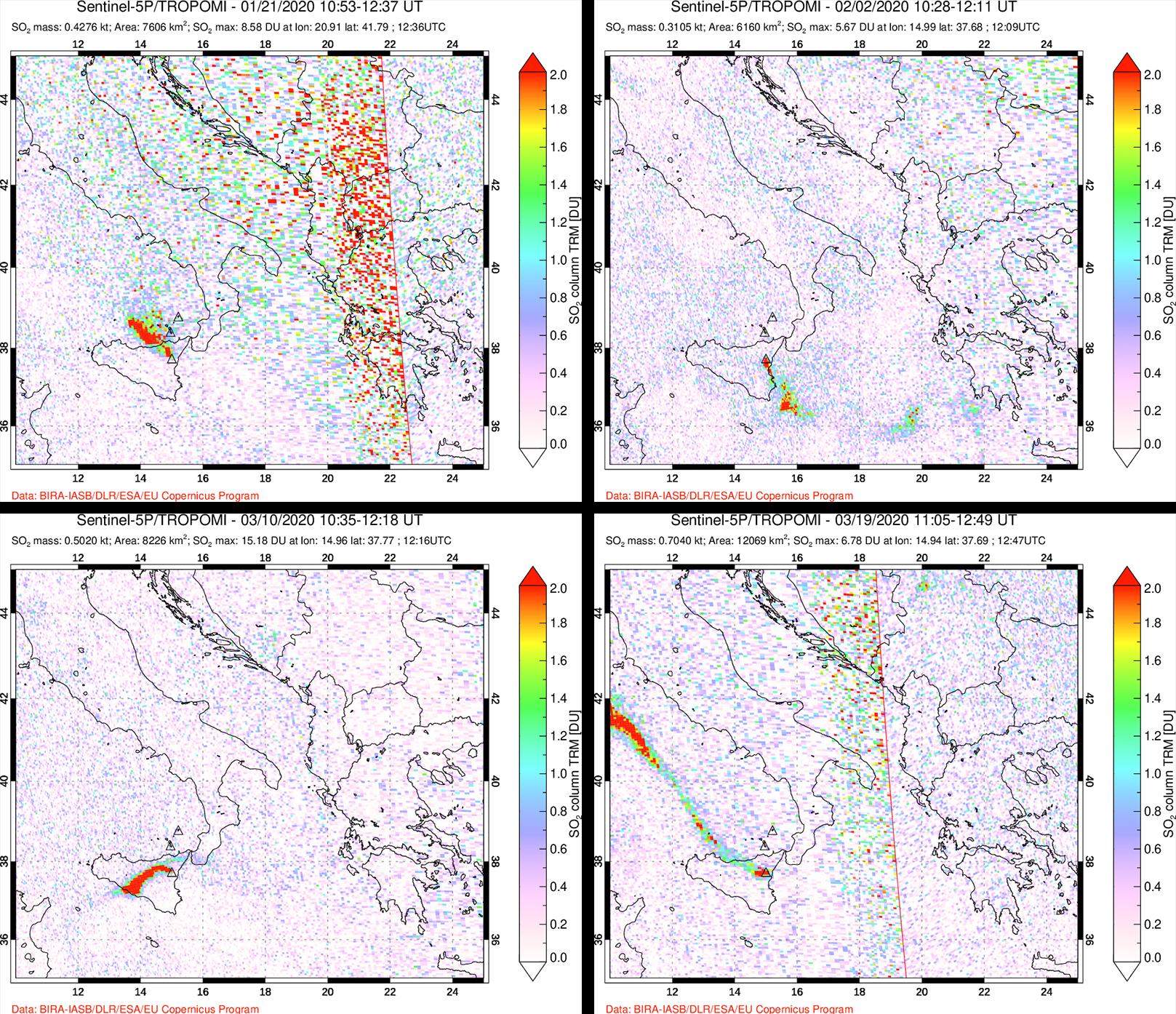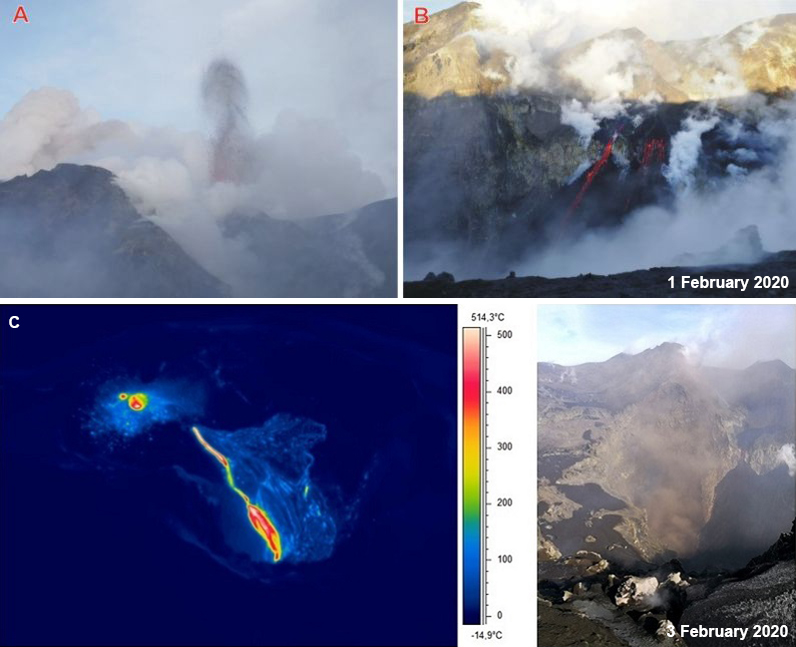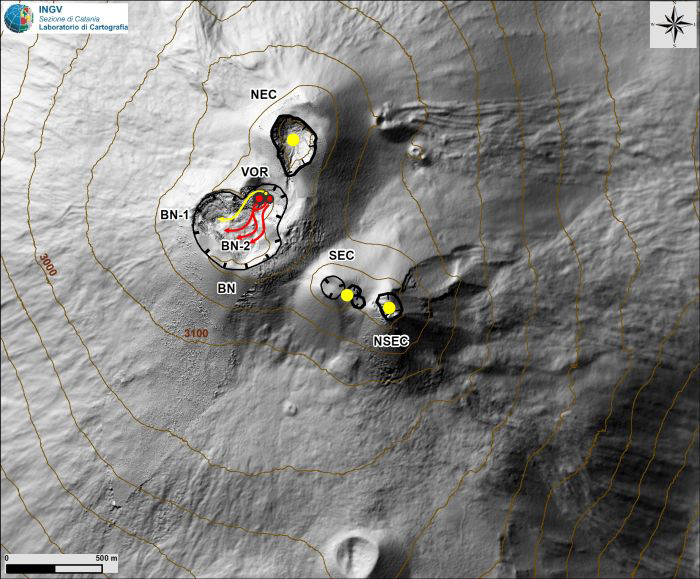Report on Etna (Italy) — April 2020
Bulletin of the Global Volcanism Network, vol. 45, no. 4 (April 2020)
Managing Editor: Edward Venzke.
Edited by Kadie L. Bennis.
Etna (Italy) Strombolian explosions and ash emissions continue, October 2019-March 2020
Please cite this report as:
Global Volcanism Program, 2020. Report on Etna (Italy) (Bennis, K.L., and Venzke, E., eds.). Bulletin of the Global Volcanism Network, 45:4. Smithsonian Institution. https://doi.org/10.5479/si.GVP.BGVN202004-211060
Etna
Italy
37.748°N, 14.999°E; summit elev. 3357 m
All times are local (unless otherwise noted)
Mount Etna is a stratovolcano located on the island of Sicily, Italy, with historical eruptions that date back 3,500 years. The most recent eruptive period began in September 2013 and has continued through March 2020. Activity is characterized by Strombolian explosions, lava flows, and ash plumes that commonly occur from the summit area, including the Northeast Crater (NEC), the Voragine-Bocca Nuova (or Central) complex (VOR-BN), the Southeast Crater (SEC, formed in 1978), and the New Southeast Crater (NSEC, formed in 2011). The newest crater, referred to as the "cono della sella" (saddle cone), emerged during early 2017 in the area between SEC and NSEC. This reporting period covers information from October 2019 through March 2020 and includes frequent explosions and ash plumes. The primary source of information comes from the Osservatorio Etneo (OE), part of the Catania Branch of Italy's Istituo Nazionale di Geofisica e Vulcanologica (INGV).
Summary of activity during October 2019-March 2020. Strombolian activity and gas-and-steam and ash emissions were frequently observed at Etna throughout the entire reporting period, according to INGV and Toulouse VAAC notices. Activity was largely located within the main cone (Voragine-Bocca Nuova complex), the Northeast Crater (NEC), and the New Southeast Crater (NSEC). On 1, 17, and 19 October, ash plumes rose to a maximum altitude of 5 km. Due to constant Strombolian explosions, ground observations showed that a scoria cone located on the floor of the VOR Crater had begun to grow in late November and again in late January 2020. A lava flow was first detected on 6 December at the base of the scoria cone in the VOR Crater, which traveled toward the adjacent BN Crater. Additional lava flows were observed intermittently throughout the reporting period in the same crater. On 13 March, another small scoria cone had formed in the main VOR-BN complex due to Strombolian explosions.
MIROVA (Middle InfraRed Observation of Volcanic Activity) analysis of MODIS satellite data shows multiple episodes of thermal activity varying in power from 22 June 2019 to March 2020 (figure 286). The power and frequency of these thermal anomalies significantly decreased between August to mid-September. The pulse of activity in mid-September reflected a lava flow from the VOR Crater (BGVN 44:10). By late October through November, thermal anomalies were relatively weaker and less frequent. The next pulse in thermal activity reflected in the MIROVA graph occurred in early December, followed by another shortly after in early January, both of which were due to new lava flows from the VOR Crater. After 9 January the thermal anomalies remained frequent and strong; active lava flows continued through March accompanied by Strombolian explosions, gas-and-steam, SO2, and ash emissions. The most recent distinct pulse in thermal activity was seen in mid-March; on 13 March, another lava flow formed, accompanied by an increase in seismicity. This lava flow, like the previous ones, also originated in the VOR Crater and traveled W toward the BN Crater.
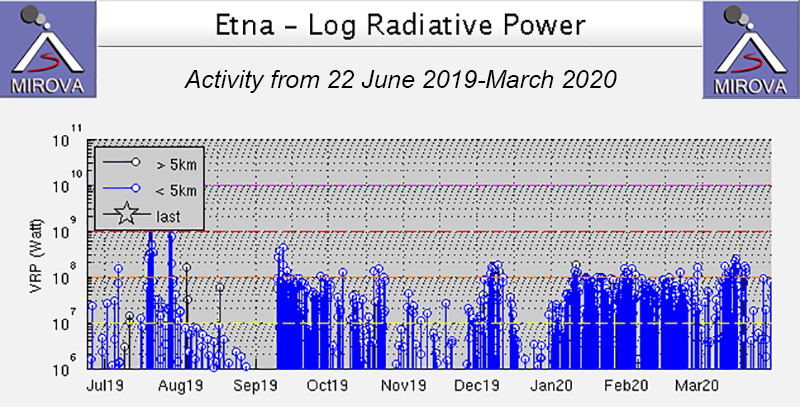 |
Figure 286. Multiple episodes of varying activity at Etna from 22 June 2019 through March 2020 were reflected in the MIROVA thermal energy data (Log Radiative Power). Courtesy of MIROVA. |
Activity during October-December 2019. During October 2019, VONA (Volcano Observatory Notice for Aviation) notices issued by INGV reported ash plumes rose to a maximum altitude of 5 km on 1, 17, and 19 October. Strombolian explosions occurred frequently. Explosions were detected primarily in the VOR-BN Craters, ejecting coarse pyroclastic material that fell back into the crater area and occasionally rising above the crater rim. Ash emissions rose from the VOR-BN and NEC while intense gas-and-steam emissions were observed in the NSEC (figure 287). Between 10-12 and 14-20 October fine ashfall was observed in Pedara, Mascalucia, Nicolosi, San Giovanni La Punta, and Catania. In addition to these ash emissions, the explosive Strombolian activity contributed to significant SO2 plumes that drifted in different directions (figure 288).
The INGV weekly bulletin covering activity between 25 October and 1 November 2019 reported that Strombolian explosions occurred at intervals of 5-10 minutes from within the VOR-BN and NEC, ejecting incandescent material above the crater rim, accompanied by modest ash emissions. In addition, gas-and-steam emissions were observed from all the summit craters. Field observations showed the cone in the crater floor of VOR that began to grow in mid-September 2019 had continued to grow throughout the month. During the week of 4-10 November, Strombolian activity within the Bocca Nuova Crater was accompanied by gas-and-steam emissions. The explosions in the VOR Crater occasionally ejected incandescent ejecta above the crater rim (figures 289 and 290). For the remainder of the month Strombolian explosions continued in the VOR-BN and NEC, producing sporadic ash emissions. Isolated and discontinuous explosions in the New Southeast Crater (NSEC) also produced fine ash, though gas-and-steam emissions still dominated the activity at this crater. Additionally, the explosions from these summit craters were frequently accompanied by strong SO2 emissions that drifted in different directions as discrete plumes.
Frequent Strombolian explosions continued through December 2019 within the VOR-BN, NEC, and NSEC Craters with sporadic ash emissions observed in the VOR-BN and NEC. On 6 December, Strombolian explosions increased in the NSEC; webcam images showed incandescent pyroclastic material ejected above the crater rim. On the morning of 6 December a lava flow was observed from the base of the scoria cone in the VOR Crater that traveled toward the adjacent Bocca Nuova Crater. INGV reported that a new vent opened on the side of the saddle cone (NSEC) on 11 December and produced explosions until 14 December.
Activity during January-March 2020. On 9 January 2020 an aerial flight organized by RAI Linea Bianca and the state police showed the VOR Crater continuing to produce lava that was flowing over the crater rim into the BN Crater with some explosive activity in the scoria cone. Explosive Strombolian activity produced strong and distinct SO2 plumes (figure 291) and ash emissions through March, according to the weekly INGV reports, VONA notices, and satellite imagery. Several ash emissions during 21-22 January rose from the vent that opened on 11 December. According to INGV’s weekly bulletin for 21-26 January, the scoria cone in the VOR crater produced Strombolian explosions that increased in frequency and contributed to rapid cone growth, particularly the N part of the cone. Lava traveled down the S flank of the cone and into the adjacent Bocca Nuova Crater, filling the E crater (BN-2) (figure 292). The NEC had discontinuous Strombolian activity and periodic, diffuse ash emissions.
Strombolian explosions continued into February 2020, accompanied by ash emissions and lava flows from the previous months (figure 293). During 17-23 February, INGV reported that some subsidence was observed in the central portion of the Bocca Nuova Crater. During 24 February to 1 March, the Strombolian explosions ejected lava from the VOR Crater up to 150-200 m above the vent as bombs fell on the W edge of the VOR crater rim (figure 294). Lava flows continued to move into the W part of the Bocca Nuova Crater.
During 9-15 March 2020 Strombolian activity was detected in the VOR Crater while discontinuous ash emissions rose from the NEC and NSEC. Bombs were found in the N saddle between the VOR and NSEC craters. On 9 March, a small scoria cone that had formed in the Bocca Nuova Crater and was ejecting bombs and lava tens of meters above the S crater rim. The lava flow from the VOR Crater was no longer advancing. A third scoria cone had formed on 13 March NE in the main VOR-BN complex due to the Strombolian explosions on 29 February. Another lava flow formed on 13 March, accompanied by an increase in seismicity. The weekly report for 16-22 March reported Strombolian activity detected in the VOR Crater and gas-and-steam and rare ash emissions observed in the NEC and NSEC (figure 295). Explosions in the Bocca Nuova Crater ejected spatter and bombs 100 m high.
Geological Summary. Mount Etna, towering above Catania on the island of Sicily, has one of the world's longest documented records of volcanism, dating back to 1500 BCE. Historical lava flows of basaltic composition cover much of the surface of this massive volcano, whose edifice is the highest and most voluminous in Italy. The Mongibello stratovolcano, truncated by several small calderas, was constructed during the late Pleistocene and Holocene over an older shield volcano. The most prominent morphological feature of Etna is the Valle del Bove, a 5 x 10 km caldera open to the east. Two styles of eruptive activity typically occur, sometimes simultaneously. Persistent explosive eruptions, sometimes with minor lava emissions, take place from one or more summit craters. Flank vents, typically with higher effusion rates, are less frequently active and originate from fissures that open progressively downward from near the summit (usually accompanied by Strombolian eruptions at the upper end). Cinder cones are commonly constructed over the vents of lower-flank lava flows. Lava flows extend to the foot of the volcano on all sides and have reached the sea over a broad area on the SE flank.
Information Contacts: Sezione di Catania - Osservatorio Etneo, Istituto Nazionale di Geofisica e Vulcanologia (INGV), Sezione di Catania, Piazza Roma 2, 95123 Catania, Italy (URL: http://www.ct.ingv.it/it/); Toulouse Volcanic Ash Advisory Center (VAAC), Météo-France, 42 Avenue Gaspard Coriolis, F-31057 Toulouse cedex, France (URL: http://www.meteo.fr/aeroweb/info/vaac/); MIROVA (Middle InfraRed Observation of Volcanic Activity), a collaborative project between the Universities of Turin and Florence (Italy) supported by the Centre for Volcanic Risk of the Italian Civil Protection Department (URL: http://www.mirovaweb.it/); Global Sulfur Dioxide Monitoring Page, Atmospheric Chemistry and Dynamics Laboratory, NASA Goddard Space Flight Center (NASA/GSFC), 8800 Greenbelt Road, Goddard, Maryland, USA (URL: https://so2.gsfc.nasa.gov/); Sentinel Hub Playground (URL: https://www.sentinel-hub.com/explore/sentinel-playground); Boris Behncke, Sonia Calvari, and Marco Neri, Istituto Nazionale di Geofisica e Vulcanologia (INGV), Sezione di Catania, Piazza Roma 2, 95123 Catania, Italy (URL: https://twitter.com/etnaboris, Image at https://twitter.com/etnaboris/status/1183640328760414209/photo/1).



